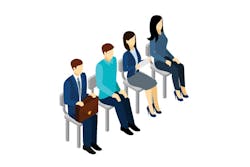Have I ever told you the reason I got into this business? What if I told you that my end goal was actually...to be a paramedic? Yes, that is correct. My mom is the one who saw the shop for sale in the newspaper and suggested I make the purchase as a way to pay for school. I thought, “Sure, I’ll just work as a firefighter and run this on the side.” Now, I went to trade school in high school and I had done paint and body work for a few years, but I had next to no business experience and frankly, I wasn’t that focused on becoming an expert business owner anyway. It was just a means to an end for me to finish school.
What’s the point of me telling you this? The point is that I know risk. I understand its value. I’ve taken tons of risks over the years, from that first day of ownership to expanding, diversifying services, completely blowing up my workflow and making the most out of my at times challenging market. And I also understand making a decision and sticking with it (see: me never finishing school and instead turning this one $900,000 per year shop into a four-location juggernaut).
But there’s one risk in business ownership that to this day, remains not only a challenge, but also a notorious crapshoot: hiring. Interviews are tough. People are either nervous or extremely well seasoned; either way, you’re not getting a true look at the person. And while a lot of us would say that we can tell in our gut if the person will be a good fit—and hey, I’m one of those people, too—let’s be honest: How many times has your gut led you astray? At some point, you can’t just keep hoping your new hires will work out; you need a system for hiring for keeps.
That’s exactly why we started group interviews (in this case, having multiple in on the hiring process). To say it’s been extremely effective to have more people than just me making the decision is an understatement. The reason is because not only does it create buy-in with whoever we pick, what I pick up on could be totally different than on what someone else picks up. As a result, turnover has become super low in my shops, especially for this industry.
So, this is how we tackle it: First, after collecting resumes and emails and sifting through those to identify the top picks, I will always do a quick 10-minute phone interview with those candidates. The whole idea is to see how they can talk when they’re in their own comfortable area. They’re at home, it’s not face to face—they should be able to handle that pretty well. So, we see how far we can get there and if, just from that first phone call, they seem to be a good fit. After that, we bring them in for the first interview. It’s typically still a short interview just with me or maybe another manager.
For any position, the goal at that point is to get it down to three people. The three best people who we think their attitude is at least close to what we’re looking for. Then, we’ll pull those three in and and interview them as a group. Typically, that group is 3–5 people and the makeup depends on what department we’re interviewing for. For a CSR, for example, we’ll have me, my bookkeeper, a team leader and an existing CSR.
The key with group interviews is that you need to train your interviewers. The CSR, for example, might know exactly what it takes to be a good CSR at my shops, but he or she might not know how to pick up on the nonverbal cues (like smiling or maintaining eye contact) that are so important to pay attention to during interviews. So, before the interview, it’s important that everyone understands the process and goals. For example, everyone might think they understand what “positive attitude” means, but we all have different definitions of that.
You still want to ask all of those behavioral questions that reveal the best insight, but you want to make sure that everyone understands the goals and what to look for. You can even assign roles, if you want.
At the end of the interview, we all have a big discussion. We talk about the pros and cons of the person, what we picked up on, their answers to questions, etc. There’s a key with this post-interview discussion, though, too: You need to make sure everyone is honest and has a chance to offer their feedback. One of the most common dangers is one voal opinion dominates the conversation. You might want to wait a few minutes after the interview is over for everyone to collect their thoughts, or let someone you know is more timid speak first. The last step is that we all vote and make a decision on the final candidate.
About the Author

